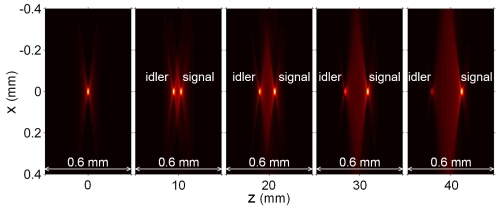A research team from the State Key Laboratory of High-Field Laser Physics, Shanghai Institute of Optics and Fine Mechanics (SIOM) of the Chinese Academy of Sciences (CAS), Zhangjiang Laboratory and ShanghaiTech University theoretically found the generation and amplification of double space-time wave packets using optical parametric amplification. The related results were published in Communications Physics under the title of "Strong double space-time wave packets using optical parametric amplification" on November 22, 2022.
The space-time wave packet proposed by Abouraddy et. al [Nature Photonics 11, 733 (2017)] is a novel spatiotemporal coupled diffraction-free pulsed beam, whose group velocity can be arbitrarily tuned from subluminal to superluminal, and whose group acceleration can also be tuned in a wide range, which also has many special characteristics like anomalous refraction, anomalous spatiotemporal dispersion, free-space dispersion, time diffraction, etc.
This new pulsed beam has been applied in many applications in weak-field optics and is certainly valuable in strong-field optics as well. However, the generation of the space-time wave packet requires spatial light modulators or phase plates for precise control of the spatiotemporal spectrum, which introduces a high "spatiotemporal correlation". The low damage threshold of spatial light modulators or phase plates limits the energy of the space-time wave packet, making it impossible to use in strong-field optics.
In this work, the research team proposes that optical parametric amplification can be used to significantly increase the energy of the space-time wave packet while maintaining its high "spatiotemporal correlation" unchanged [Figure 1]. The team found that the space-time wave packet and the optical parametric amplification satisfy the same distribution in the momentum space (or the Fourier space), and the two are mathematically equivalent [Figure 2]. Using this method, not only the energy of the space-time wave packet can be amplified, but also another space-time wave packet (idle light) can be generated, only the wavelength and group velocity of the two are different, thus forming a high-energy double space-time wave packet [Figure 3]. The discovery of the double space-time wave packet also enables fast switching of the wavelength and group velocity of the input space-time wave packet (signal light).
This work is a key step in the development of the space-time wave packet from weak-field optics to strong-field optics.

Figure. 1. Optical parametric amplification of space-time wave packet. (Image by SIOM)

Figure. 2. (a) Space-time wave packet in momentum space, (b) schematics of optical parametric amplification, (c) momentum and energy conversions of optical parametric amplification, (d) optical parametric amplification in momentum space. (Image by SIOM)

Figure. 3. Generation and propagation of double space-time wave packet. (Image by SIOM)
Article website:
https://doi.org/10.1038/s42005-022-01085-w
Contact:
WU Xiufeng
General Administrative Office
Shanghai Institute of Optics and Fine Mechanics, CAS
Email: xfwu@siom.ac.cn
Web: http://english.siom.cas.cn/